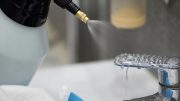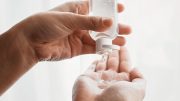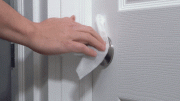Sure, you’ve got a product that says “kills germs” under your sink, but will it really destroy the new coronavirus on surfaces? Turns out that if you’re using a disinfectant the same way as a regular cleaner, you might not actually be disinfecting at all. To make sure you’re destroying 99.9% of viruses and bacteria, doing these three things is critical.
And one quick note on EPA registration numbers: make sure to look for “EPA Reg No.” as there can sometimes be another EPA number on there as well. Then, enter the first two sections of the number into List N to find the product. (If you enter the third part, the search won’t work properly.) Some products only list the first two parts. Yeah, it’s confusing.
Video Transcript:
[GEORGE] Nothing like a germ-free kitchen.
[ANTI-GEORGE] That’s not germ-free!
[GEORGE] But I just disinfected it.
[ANTI-GEORGE] No you didn’t, you made three big mistakes.
[GEORGE] Apparently I didn’t use nearly enough disinfectant.
Sprays are made up of tiny, tiny droplets and it turns out that when those tiny droplets hit a surface, they don’t really spread out that much.
So right here the surface is in direct contact with the disinfectant so there’s germ killing happening, but right here there isn’t.
Also, if there’s gunk or dirt it can actually shield viruses and bacteria kind of like an umbrella. So what you want to do is you want to clean with soap and water first, and then disinfect.
And you have to use a lot of disinfectant. Hey little guy. Don’t just moisten a surface, you have to fully wet it, and that means using a lot more disinfectant than you think you need.
By the way this applies to wipes, too. If you read the label it usually says something like use enough wipes to fully wet the surface. That’s a lot of wipes.
Ok, how am I doing?
[ANTI-GEORGE] I mean, you know, uhh, fine.
[GEORGE] All right next mistake.
I also didn’t give my disinfectant enough time to fully do its job before wiping it away. Once this is wet, you need to let it sit for way longer than you think.
Why? Well we don’t know the exact details of how active ingredients in disinfectants react with germs to kill them, but we can nevertheless write it out as kind of a general chemical reaction: germs plus disinfectants yields dead germs.
Some chemical reactions are very fast others are a lot slower. The speed of this particular reaction depends a lot on the type of germ, the disinfectant, and a bunch of other factors, but to make sure that the disinfectant has the time to do its job fully you might need to let it sit for two, three, four, five, sometimes even ten minutes. And yep, same goes for wipes.
By the way, this is called the contact time and it’s usually listed very clearly on the label of whatever product you’re using.
How was that? So, I should go on to the third thing? Great.
Speaking of the product you’re using I wasn’t using a disinfectant at all. So here’s the deal, there are three types of household products you might use on countertops, doorknobs, light switches, etc. Cleaners, sanitizers, and disinfectants.
Cleaners like this one or, let’s say vinegar, are great at cleaning, which is great. But we have no idea how good or how bad they are at killing viruses, the manufacturers simply have not done those tests.
Sanitizers and disinfectants on the other hand are regulated by the EPA as pesticides, and the EPA has strict rules about what can be labeled a sanitizer versus a disinfectant.
Generally speaking, sanitizers are tested against only bacteria, disinfectants are tested against bacteria, but they can also be tested against viruses or other microbes.
Once you get deeper into the regulations it gets real complicated real fast. But let’s be real, what you actually want to know is does the product you’re using kill the new coronavirus?
Because this virus is so new there hasn’t been enough time to study what products destroy it, but the EPA has put together a list of products they expect will do the job based on research with viruses that are more difficult to kill than SARS-CoV-2, like rhinovirus, or research with viruses that are similar to SARS-CoV-2 like other human coronaviruses.
The best way to make sure a product has the EPA’s blessing is to go online and ask the EPA. So you don’t literally ask the EPA, but if you go online and check their website you’ll find something called List N. You open up the List N tool and you see if something that you’ve got in your house, or something that you want to buy is on that list.
If it is it means that the EPA expects that that product will kill the new coronavirus if used as directed.
If you really want to be sure your product is on List N you can look for its EPA registration number on the label and enter that in online. This can get kind of complicated, so check out the description for more details.
Now last I checked there were more than 420 products on this list, so there’s actually a pretty good chance that something in your house is on it.
[ANTI-GEORGE] Four twenty products. Nice.
[GEORGE] Okay so what’s the bottom line? Basically if you want to be sure that you’re killing 99.9% of bacteria and viruses start off by using the right product, use enough of it, and let it sit long enough for it to be able to fully do its job.
You’ll find detailed instructions on all of those things on the label, can’t escape the fine print.
Also please be safe, disinfectants are for external surfaces only, they are not for your body, any part of your body. They can’t tell the difference between a virus particle and a lung cell, and they will happily destroy both of those things.
So please don’t eat, drink, inhale, inject, hotbox, lick, or otherwise insert any disinfectant into any part of your body. And don’t mix household cleaners, it doesn’t make a super cleaner, all it does is risk creating lots of toxic gas, and you don’t want that. We made a whole video about this I’ll post a link in the description.
Lastly if you cannot get access to an EPA registered disinfectant because they’re sold out everywhere, it’s okay, scrub down with soap and rinse with water. Alright folks go forth and disinfect.
[ANTI-GEORGE] I’ll give you a little video like a, like a D, okay? Where were the animators on this like do they even do anything anymore? You know you could have animated like half this video, instead have to look at your face. The best part of this video were the like 10 seconds that I was in, but you, just, just awful. Awful. Go back to writing don’t, don’t try and be on camera, it’s it’s not good for anyone involved. Just just let Sam do it, okay? What are you even doing here? Alright, stick to producing, okay? Stick to producing.









To the ACS:
I an explanatory video begins by telling me I’m a moron and doing something incorrectly, I have no compunction about turning it off immediately. OTOH, why doesn’t the EPA recommend to the manufacturers of cleaners, sanitizers, and disinfectants to include a surfactant in their product.
Hi George, this is a great informative video, there is a lot of people who are not using disinfectants the correct way and unfortunately leading to more infections or even intoxications. Can I repost this video or use some of your copy to help educate some more people?
Kitchen materials should contain more copper. Copper’s electrical properties destroy viruses and bacteria. This has been known for centuries in the Medical Science, how the knives were made from copper did not infect patients unlike normal steel knives. Sadly this is almost forgotten fact. And in the Middle Ages people stored water in copper kettles for the same reason.
I have been using disinfectant the wrong way from such a long time. Thank you for sharing this. Your video was so informative. I am definitely sharing this with my friends and family.